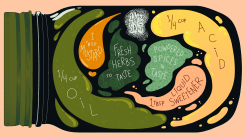Turn Your Favorite Salad Into a Sandwich
The no-carb craze has taken many forms over at least two decades—there’s Atkins, Paleo, the carnivore diet, Whole 30—all special in their own way, but with a shared distrust and dislike of bread. To keep up with the times, sandwich places commonly offer their wares in the form of salads, with fillings ripped from buns and rolls, chopped and distributed across a bed of leaves.

It would actually be hard for me to choose between a really good sandwich and a really good salad, and I think transformation from one to the other should be a two-way street. If sandwiches can become salads, salads can become sandwiches, you just have to tweak the proportions involved. Let me walk you through the process of converting salad to sandwich, using my personal favorite, the wedge.
Isolate your star
Salads are (usually) comprised mostly of greens. Protein or a hearty vegetable often ranks second in terms of portion size, and the remaining ingredients serve as delicious accessories. But lettuce should not be the focus of a sandwich, that honor should go to the protein, or the best-tasting vegetable. (Lettuce-less salads are usually easier. The caprese is already proportioned perfectly; just transfer it to bread.)


When we think about a wedge salad and what makes it great, we often think about the bacon, the blue cheese, and—if they are in season—the tomatoes. A BLT kinda deal is an obvious choice here, with equal respect and space given to the bacon and the tomato (again, if they are in season). Once you have the star(s) of the sandwich identified, turn your attention to the back-up dancers.
Dress your greens
Iceberg is the classic choice for a wedge, and I wouldn’t change that, but I would shred it, because shredded iceberg is my absolute favorite sandwich lettuce. I would shred my romaine too, but not delicate leaves like spinach. But no matter which lettuce your transferring from bowl to bread, you should take a moment to dress it.
After all, one of the best things about eating a salad is that the leaves are tossed in something that makes them taste less leaf-like, and you should bring that energy to your sandwich. You may think I’m advocating for blue cheese dressing-drenched shreds, but I’m not. (I have other plans for the cheese.) Gloppy lettuce is not what we’re after, a little bit of red wine vinegar, some olive oil and balsamic, or a tiny bit of a simple vinaigrette will honor the leafy origins of the meal while also making everything taste a little bit better.
Secure the crumbly tumbly bits
About that blue cheese—those beautiful backup girls. Blue cheese provides fat and flavor, but its crumbles are also prone to tumbling away, making them a poor candidate for a sandwich, and they’re not the only little bit that needs to be secured.
Besides the lettuce, everything in a wedge salad is a crumbly, tumbly bit, destined to escape your bread unless you do something. For each bit, you have three options: change the size, smash it into something with staying power, or blend it into your mayo.
For bacon, tomato, and red onion, changing the size is enough. Slice instead of dice, and these ingredients are rendered sandwich-friendly. Blue cheese needs a little more work. The easy route—and the one I took above—is to spread a thick layer of mayo on the bottom piece of bread, then smash the crumbles into the mayo. This also works with chopped olives, capers, and anything else that is small and round. Mayo isn’t your only choice for substrate either: Sandwiches based on salads that feature chickpeas can use hummus, and fresh goat cheese can become the substrate itself.
The other option is to make blue cheese mayo, which I already have a recipe for. And cheese isn’t the only thing you can blend into mayo. Herbs, alliums, and any appropriate seasoning can be whirred right in for even flavor distribution.
From there, it is just a matter of piling it all on bread, which is where you should feel free to be creative. I’m always in favor of a nice roll, but I’m sure there are salads that beg for a sturdy, seedy multi-grain, or a nice acidic sourdough.
Claire is Lifehacker's Senior Food Editor. She has a B.S. in chemistry, a decade of food journalism experience, and a deep love for mayonnaise and MSG.
RECOMMENDED NEWS

5 Ways to Use Up Leftover Rice
When you find yourself with leftover rice, your first instinct may be to use it to make fried rice. ...

What Your Coleslaw Needs Is a Little Pepper Jelly
Coleslaw can be a tricky thing. Bad slaws are watery and bland, but a good one provides a perfect sw...
![How to Make an Egg Yolk Omelette Without Angering James Corden [Updated]](https://img.gamelinxhub.com/images/hero-image.fill.size_245x138.v1699833817.jpg)
How to Make an Egg Yolk Omelette Without Angering James Corden [Updated]
I am convinced being rich and famous does terrible things to your brain. It seems to rob you of empa...

What to Do Instead of Buying a Giant Thanksgiving Turkey
When buying the big bird for the big meal, aiming for 1 1/2 pounds of turkey (including bones and al...

Three Ways to Use Up Puff Pastry Scraps
Puff pastry can transform even the simplest ingredients into a dazzling meal or dessert. Sadly, ther...

No-Cook Meals to Make During a Heat Wave
Heating the inside of my home while it is very hot outside of it is not something I enjoy. During a ...
Comments on "Turn Your Favorite Salad Into a Sandwich" :